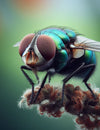
In the relentless battle against mosquito-borne diseases, understanding the intricacies of specific mosquito species becomes imperative. Dengue fever, a significant global health concern, is primarily transmitted by the Aedes aegypti mosquito. This blog post aims to unravel the mysteries surrounding the dengue mosquito bite, offering a comprehensive guide to equip readers with the knowledge needed to protect themselves and their communities. From recognizing the distinct characteristics of a dengue mosquito bite to learning about the mosquito's habits, transmission cycles, and preventive measures, we delve into the multifaceted world of dengue to empower you with the information necessary for proactive health management. Join us on this exploration as we uncover everything you should know about the dengue mosquito bite – an essential step in fortifying ourselves against the threats posed by this pervasive vector-borne illness.
Recognize Bite of Dengue and Normal Mosquito
Distinguishing Dengue Mosquito Bites from Regular Mosquito Bites
Mosquito bites are an unfortunate reality of warm weather, but understanding the differences between bites from the common mosquito and those of the Aedes aegypti mosquito responsible for transmitting dengue fever is crucial. Dengue mosquito bites often exhibit unique characteristics that can aid in differentiation. Unlike typical mosquito bites that may cause mild irritation, dengue mosquito bites tend to be more painful. Individuals who have experienced both types of bites often describe the sensation of a dengue mosquito bite as a sharper and more intense pain. Additionally, dengue mosquito bites are known for their distinctive appearance.
Key Characteristics of Dengue Mosquito Bites
Identifying the key characteristics of dengue mosquito bites is essential for early detection and timely medical attention. One of the hallmark signs is the presence of a small, red spot surrounded by a halo of redness. This distinctive pattern, often referred to as the "white island in a red sea," is a telltale sign of a dengue mosquito bite. Unlike typical mosquito bites that may appear as random, scattered marks, dengue bites often manifest as a cluster of these red spots. It's crucial to pay attention to the evolution of these bites over time, as they can progress to a more pronounced rash. Being vigilant in recognizing these key characteristics can prompt individuals to seek medical assistance promptly, contributing to early diagnosis and appropriate management of dengue fever.
When Does Dengue Mosquito Bite
Day vs. Night: Dengue Mosquito Feeding Patterns
Understanding the feeding patterns of the dengue mosquito is pivotal in devising effective preventive strategies. Unlike some other mosquito species that predominantly bite during the evening, the Aedes aegypti mosquito, responsible for transmitting dengue fever, is known to be particularly active during the day. These mosquitoes are characterized by their daytime biting habits, with peak activity observed during the early morning and late afternoon. This unique behavior poses a distinct challenge, as individuals may be less vigilant during daylight hours. Exploring the day-to-night feeding patterns of the dengue mosquito sheds light on the importance of comprehensive prevention measures throughout the day.
Seasonal Variations in Dengue Mosquito Activity
Dengue transmission is not a constant threat throughout the year; instead, it often exhibits seasonal variations influenced by factors such as temperature and rainfall. Understanding these patterns can be instrumental in anticipating and mitigating the risk of dengue outbreaks. In regions where dengue is endemic, there is often a peak in mosquito activity during the warmer and wetter months. The breeding and survival of the Aedes aegypti mosquito are closely tied to environmental conditions, making it crucial to be aware of seasonal fluctuations. By recognizing the times of heightened risk, communities can implement targeted mosquito control measures and public health campaigns to minimize the impact of dengue during peak seasons.
How Does Dengue Mosquito Look Like
Identifying the Aedes Aegypti: Appearance and Features
The Aedes aegypti mosquito, notorious for its role in transmitting dengue fever, possesses distinctive features that set it apart from other mosquito species. Recognizing these characteristics is essential for effective mosquito control and disease prevention. Aedes aegypti mosquitoes are relatively small, with a size ranging from 4 to 7 millimeters. They are identifiable by their dark coloration, often featuring a combination of black and white markings on their body and legs. One of the key distinguishing features is their characteristic lyre-shaped marking on the thorax. Understanding these visual cues empowers individuals to differentiate Aedes aegypti from other mosquito species, contributing to targeted efforts in eradicating or controlling their population.
Contrasting Dengue Mosquito with Other Mosquito Species
While mosquitoes share some common characteristics, each species exhibits unique traits that are crucial for identification and disease prevention. Contrasting the Aedes aegypti mosquito with other mosquito species highlights the specific attributes that make it a significant health concern. Unlike many mosquitoes that prefer to breed in natural bodies of water, Aedes aegypti thrives in artificial containers, such as water-filled tires and flowerpots. Understanding the preferred breeding habitats of the dengue mosquito aids in targeted mosquito control efforts. Additionally, the distinctive daytime biting behavior of Aedes aegypti sets it apart from mosquitoes that are primarily active during the evening. Recognizing these differences enhances community awareness and the implementation of effective preventive measures against dengue fever.

What To Do if Dengue Mosquito Bites You
Immediate Steps After a Dengue Mosquito Bite
Being proactive in the aftermath of a dengue mosquito bite is crucial for minimizing the potential impact of the virus. Immediately after being bitten, it's advisable to clean the affected area with mild soap and water to reduce the risk of infection. Applying an antiseptic ointment and an anti-itch cream can help alleviate discomfort and prevent scratching, which could lead to further complications. Over-the-counter pain relievers can also be taken to manage pain and reduce inflammation. It's essential to avoid excessive scratching, as it can increase the risk of infection and leave lasting scars. These immediate steps provide a preliminary line of defense while individuals monitor for any developing symptoms of dengue fever.
Recognizing Symptoms and Seeking Medical Attention
Vigilance in recognizing the symptoms of dengue fever is paramount for early diagnosis and appropriate medical intervention. Common symptoms include high fever, severe headaches, pain behind the eyes, joint and muscle pain, rash, and mild bleeding. If an individual experiences these symptoms after a dengue mosquito bite, seeking medical attention promptly is imperative. Dengue can progress rapidly, and early detection enhances the effectiveness of medical care. Medical professionals may conduct diagnostic tests to confirm the presence of the dengue virus and assess the severity of the infection. Timely medical attention not only aids in managing symptoms but can also prevent the progression to severe dengue, which can be life-threatening. If you suspect dengue fever, do not hesitate to consult with a healthcare professional for proper evaluation and guidance.
Does Dengue Kill People?
Dengue fever, while often a self-limiting illness, can, in some cases, lead to severe complications that pose a risk to life. The majority of dengue cases result in mild symptoms, such as fever, headaches, and joint pain, and individuals typically recover with appropriate care. However, a small percentage of cases progress to severe dengue, also known as dengue hemorrhagic fever or dengue shock syndrome.
Severe dengue can be life-threatening due to complications such as plasma leakage, severe bleeding, and organ impairment. The risk factors for developing severe dengue include prior infection with a different dengue virus serotype, a weakened immune system, and certain underlying health conditions. Prompt and accurate medical intervention is crucial in managing severe dengue, and access to healthcare resources significantly influences outcomes.
Recognizing Dengue Symptoms: From Mild to Severe
Dengue fever manifests across a spectrum of symptoms, varying in intensity from mild to severe. Understanding the different presentations is crucial for early detection and appropriate medical attention. Here's a breakdown of the symptoms, ranging from the more manageable manifestations to the potentially severe complications associated with dengue:
Mild Case Dengue Symptoms:
-
High Fever: The onset of dengue is often marked by a sudden, high-grade fever, a prominent feature in both mild and severe cases.
- Headaches: Individuals may experience intense headaches, particularly behind the eyes, contributing to overall discomfort.
- Joint and Muscle Pain: Dengue is notorious for causing severe joint and muscle pain, earning it the colloquial term "breakbone fever."
- Skin Rash: A skin rash, featuring small red or white patches, may develop a few days after the onset of fever, adding to the array of symptoms.
Severe Symptoms of Dengue:
-
Severe Bleeding: In more critical cases, dengue can lead to mild bleeding, such as nosebleeds or gum bleeding. However, severe bleeding is a concerning complication that necessitates immediate medical attention.
- Plasma Leakage: Severe dengue can result in plasma leakage, leading to fluid accumulation, respiratory distress, and potentially fatal complications.
- Organ Impairment: In some instances, dengue can cause organ impairment, affecting the liver, heart, or other vital organs, further emphasizing the importance of swift medical intervention.
Recognizing these symptoms and their severity is crucial for individuals and healthcare professionals alike. Seeking prompt medical attention, especially in regions where dengue is prevalent, ensures accurate diagnosis and appropriate care, contributing to better outcomes for those affected by this mosquito-borne illness.
Preventing Dengue Mosquito Bites: Tips and Techniques
Mosquito Repellents: What Works Best
Effectively preventing dengue mosquito bites involves a strategic use of mosquito repellents. Not all repellents are created equal, and understanding what works best is essential for personal protection. Look for repellents containing active ingredients such as DEET, picaridin, or oil of lemon eucalyptus, as these have proven efficacy against Aedes aegypti, the dengue mosquito. Applying the repellent to exposed skin and clothing provides a barrier that deters mosquitoes from landing and biting. It's important to follow the product's instructions regarding application frequency and concentration to ensure maximum effectiveness. Incorporating mosquito repellents into your daily routine, especially during peak mosquito activity hours, is a proactive measure in reducing the risk of dengue mosquito bites.
Protective Clothing and Bed Nets
An additional layer of defense against dengue mosquitoes involves the use of protective clothing and bed nets. Wearing long-sleeved shirts, long pants, socks, and closed shoes can significantly reduce exposed skin, minimizing the chances of mosquito bites. Opt for light-colored clothing, as mosquitoes are often attracted to darker colors. When indoors, especially during sleep, bed nets treated with insecticide provide a physical barrier, preventing mosquitoes from accessing individuals. Ensuring that bed nets are properly installed and free from holes is crucial for their effectiveness. These simple yet impactful measures contribute to a comprehensive approach to preventing dengue mosquito bites, both outdoors and in the sanctuary of your home.




This is just plain wrong. There is no scientific evidence, let alone proof, that dengue mosquito bites near dusk or dawn. Nor is it true that its bite is more itchy/redder than the regular mosquito’s.